You'll love these perfect vegan yeast donuts! Fluffy and delicious, this recipe is as close as it gets to a classic glazed Krispy Kreme donut.

Jump to:
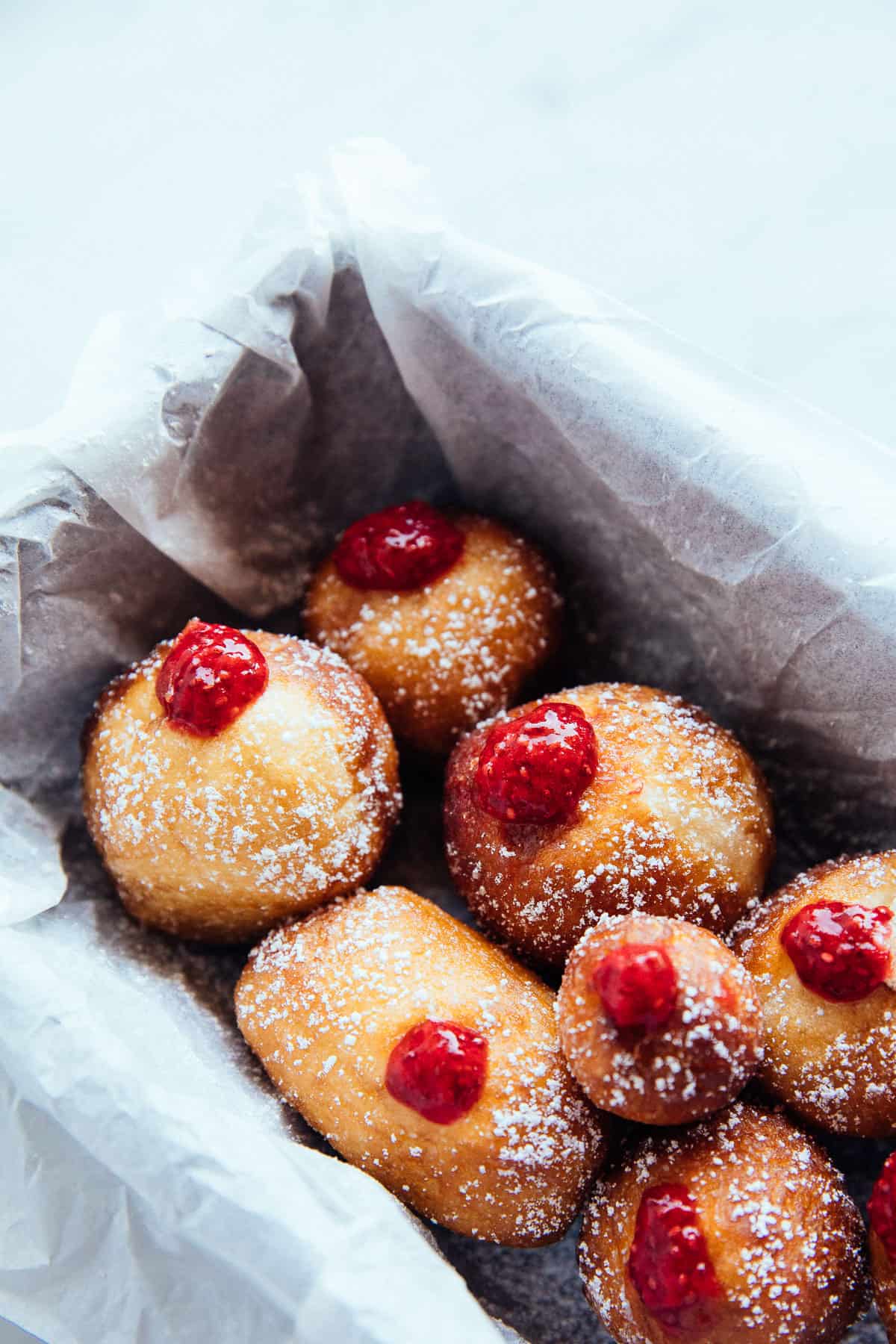
🍩 Vegan Krispy Kreme Yeast Donuts
Krispy Kreme is known for its soft, yet chewy donuts that melt in your mouth. Their classic yeast donut with a rich sugar glaze certainly deserves its bestselling status.
It also comes with a whopping 33-item ingredient list.
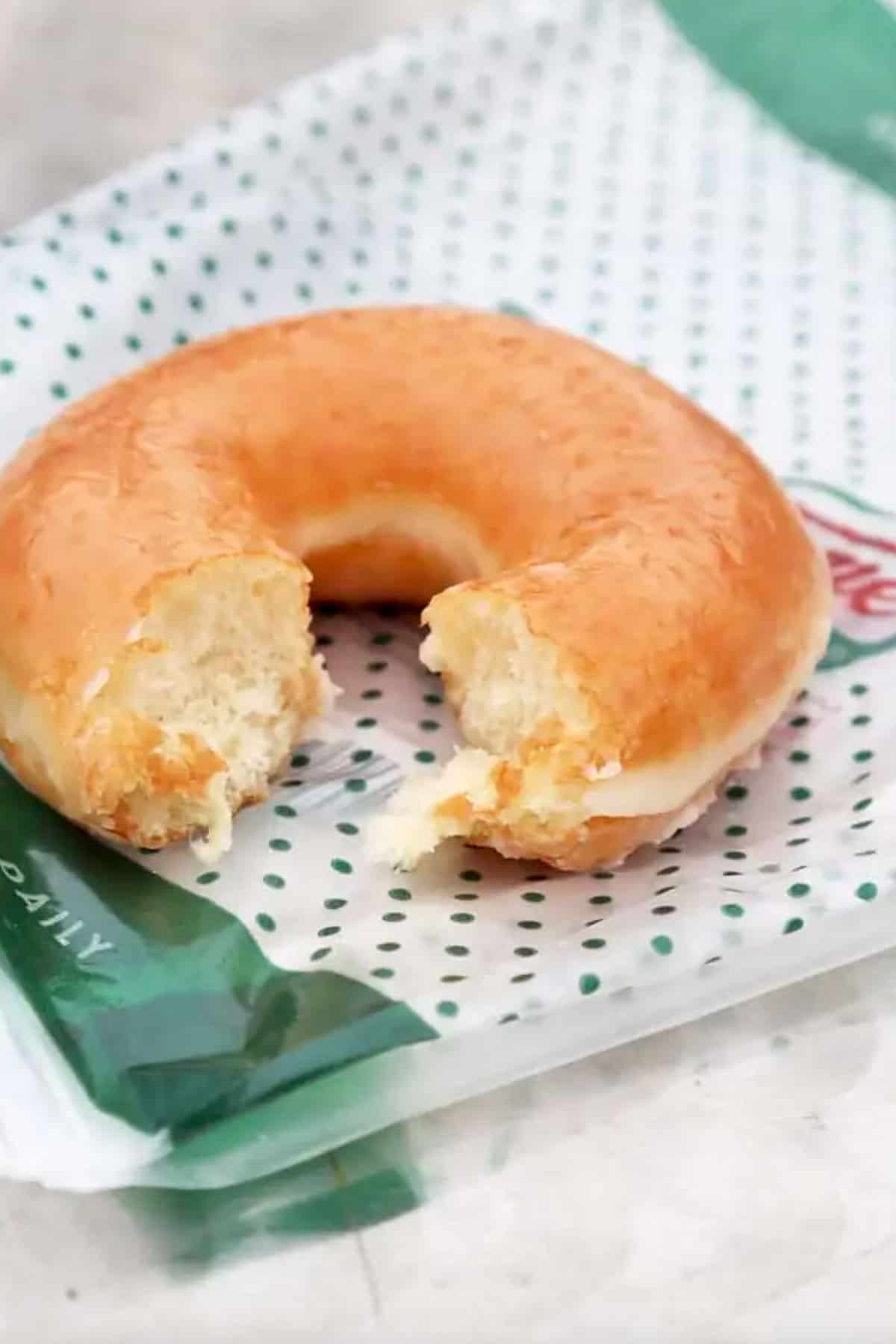
Here's an alternative with far fewer ingredients—all of which we can easily pronounce! It is also vegan thanks to easy swaps from an everyday pantry.

🧈 Vegan Donuts Ingredients
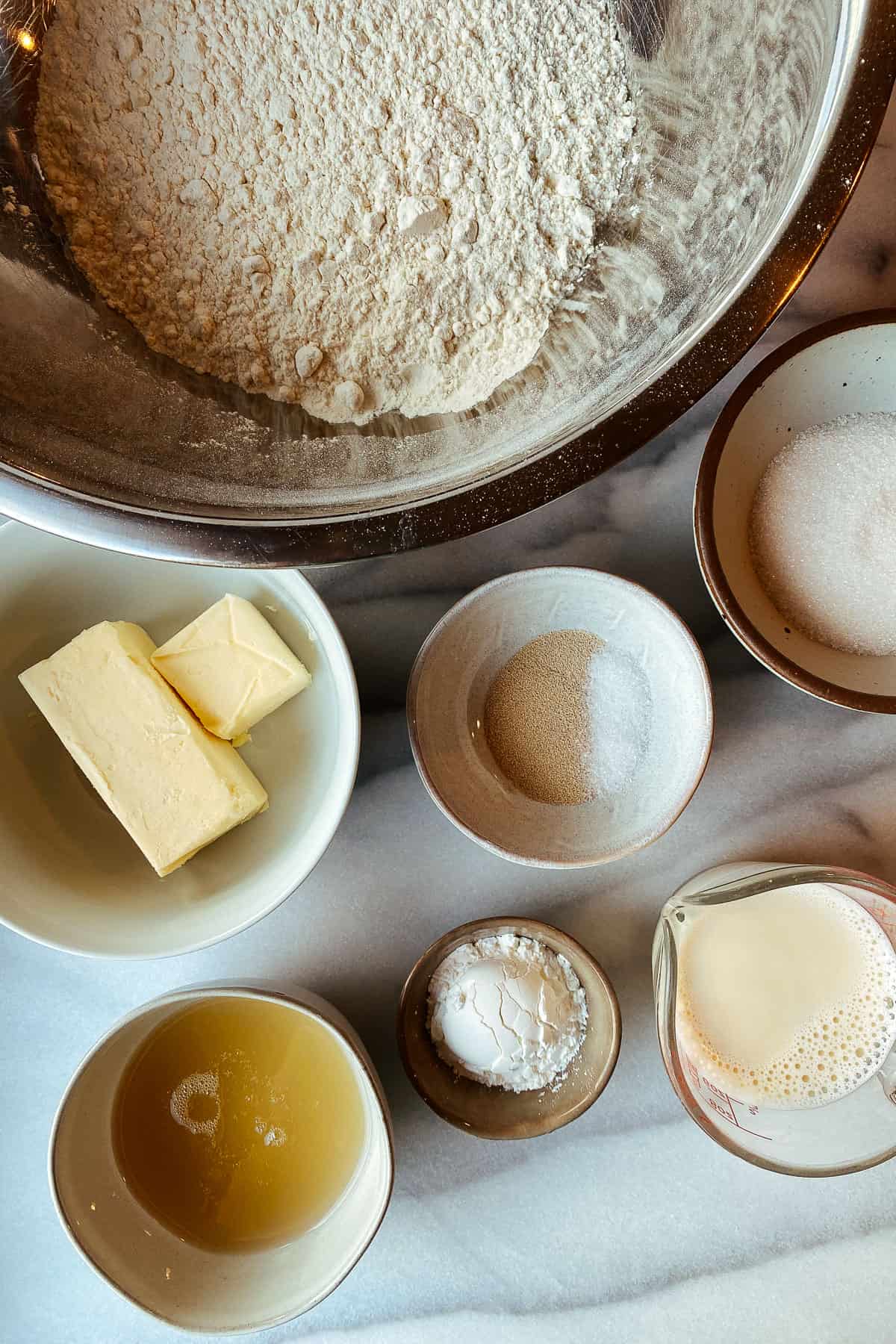
- All-Purpose Flour: I used King Arthur's unbleached AP flour that has 11.7% protein content. No sifting necessary. You may also use bread flour which is higher in protein and therefore provides more elasticity to the dough to trap more air pockets and make the donuts even softer.
- Instant Yeast: Feel free to use active dry yeast as well. In either case, make sure to bloom the yeast first with lukewarm water and a bit of sugar to test whether it's still alive.
- Aquafaba: Replacing eggs has never been easier! This diluted "chickpea broth" has dissolved starch and saponins which will slow the collapse of foam and provide stabilization.
- Cornstarch: Aquafaba isn't a great binding agent on its own so we need to add another source of starch.
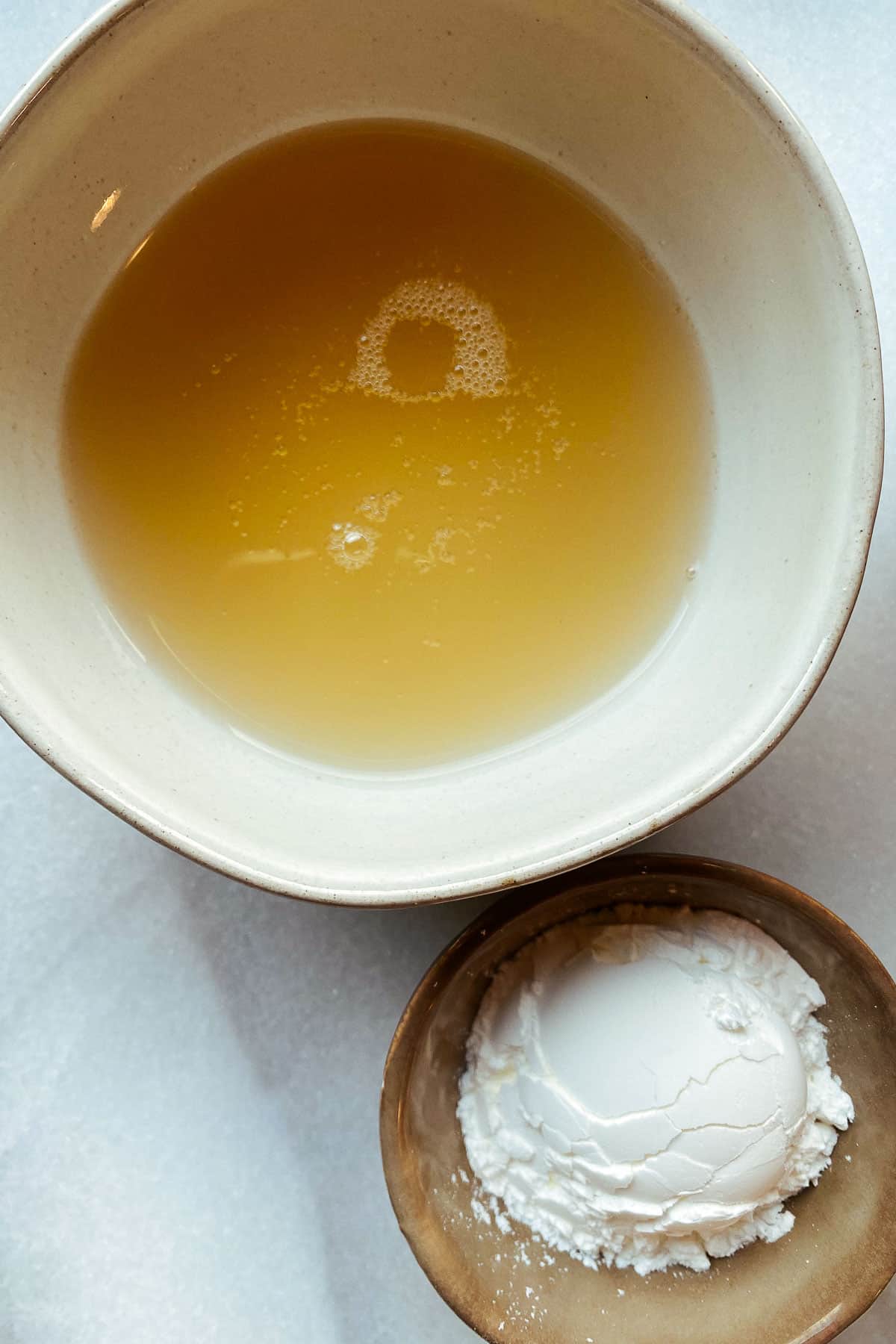
- Sugar: We'll use granulated sugar. For a 100% vegan donut, pay attention to the kind of sugar you're using. Many refined sugars are processed with bone char to take on a bright white color. In the U.S., the sugar will definitely be vegan if it's organic, “unrefined”, or made from beets.
- Salt: The recipe is written for regular table salt. Double the volume if using Kosher (same weight).
- Non-dairy milk: I use soy milk where the only ingredients are soybean and water. Any unflavored, unsweetened plant milk should work. Just be mindful of options with strong aromas such as coconut milk as they may impart some flavor.
- Vegan Butter: Room temperature butter added towards the end of kneading will somewhat soften the gluten structure for a fluffier and shiny dough. I used Earth Balance salted sticks.
- Frying Oil: Using an oil with a high smoke point is essential. I used vegetable oil. Safflower, peanut, soybean, sunflower, or canola oils will work as well.

For the glaze, we'll use powdered sugar, non-dairy milk, and a tiny bit of vegan butter for the shine.
🥣 How to Make Raised Donuts
Make the Egg Replacer
Mix aquafaba and cornstarch and set aside.
Bloom the Yeast
Mix the yeast with lukewarm water and sugar; set aside until bubbly.
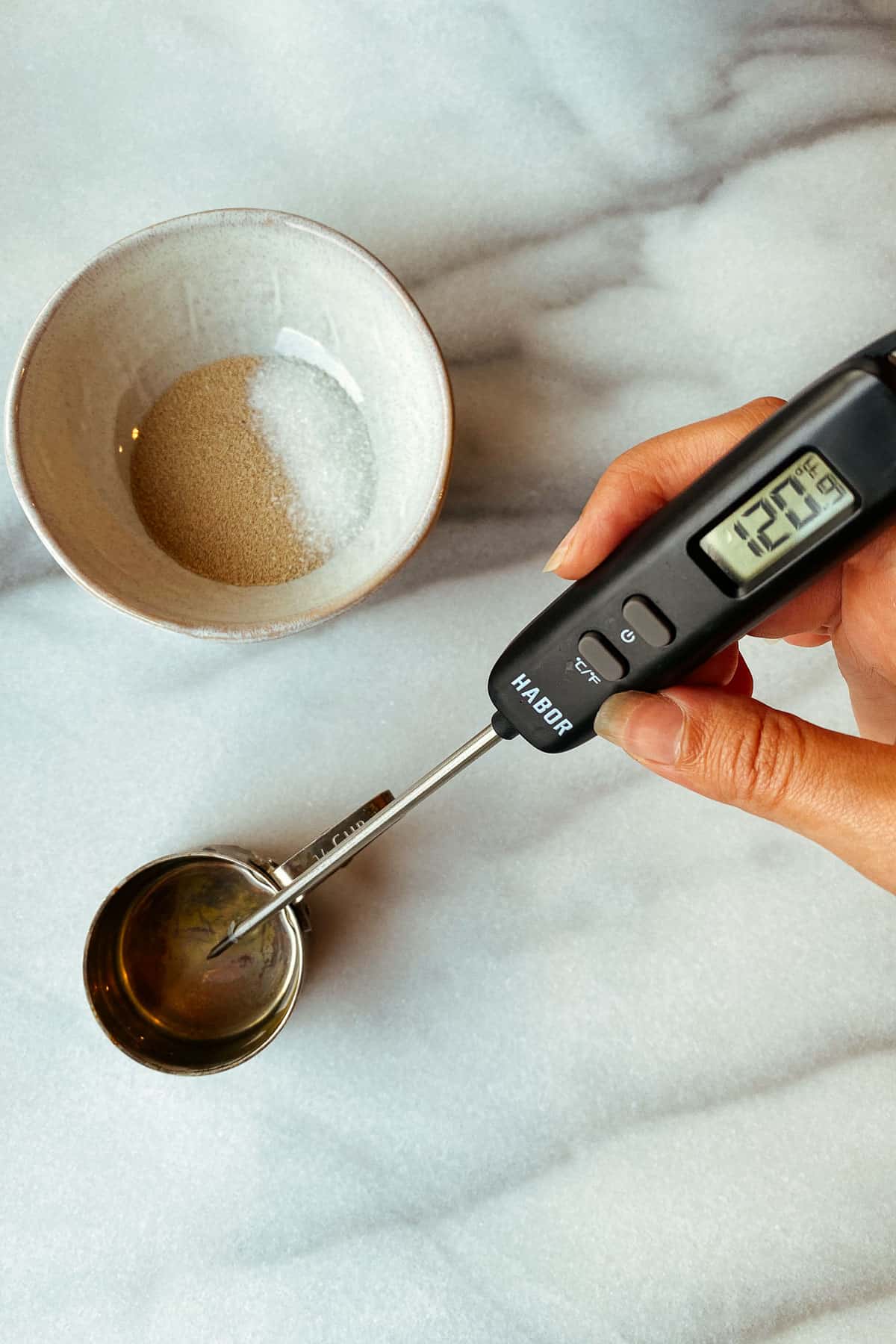
Knead and First Proof
Place all dry ingredients (flour, sugar, salt) into a large bowl and make a well in the center. Pour in the aquafaba & cornstarch mixture, soymilk, and the yeast mixture.
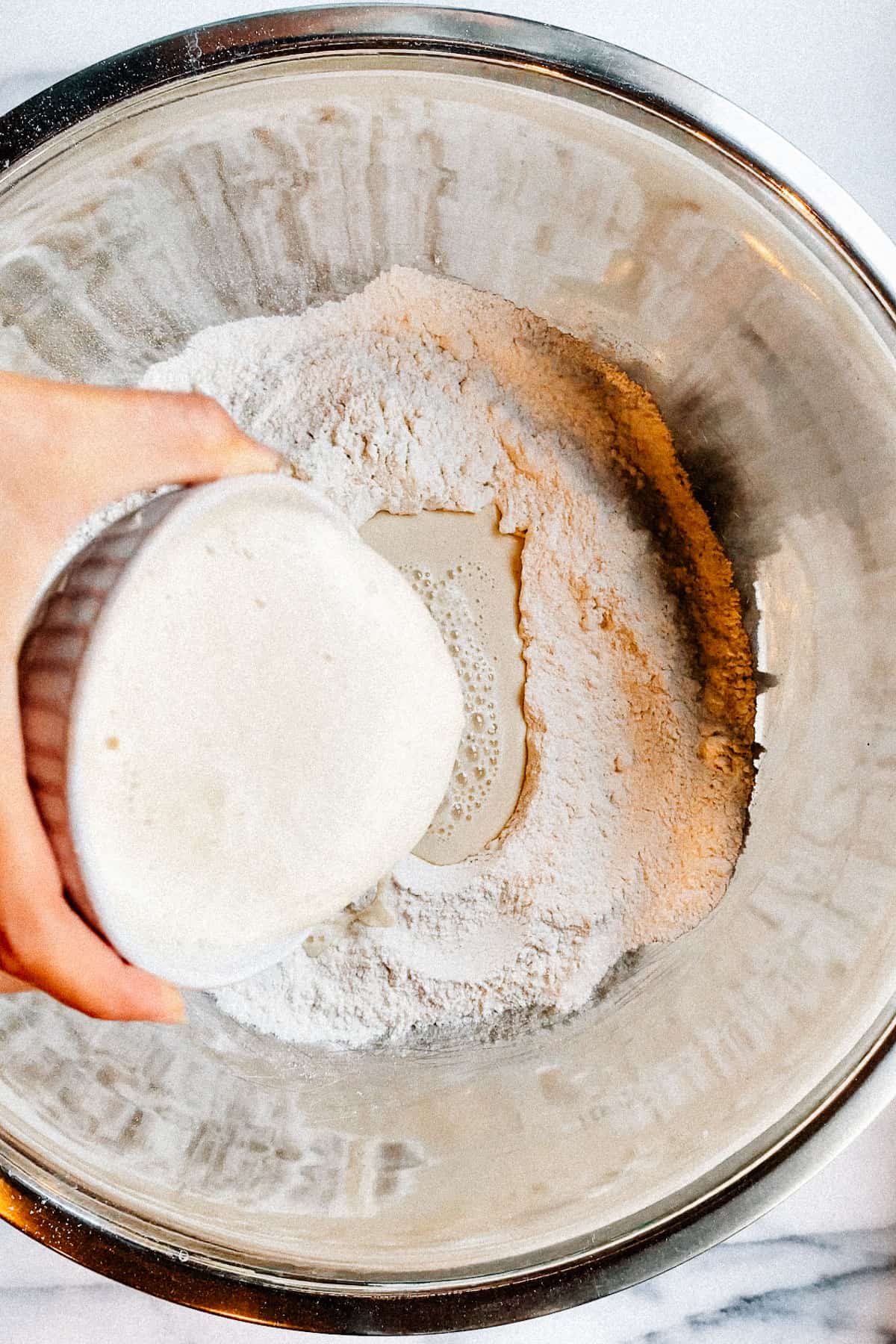
Mix with a wooden spoon until the dough somewhat comes together. If you want an easier time kneading, let this coarse mixture rest for 30 minutes to autolyse.
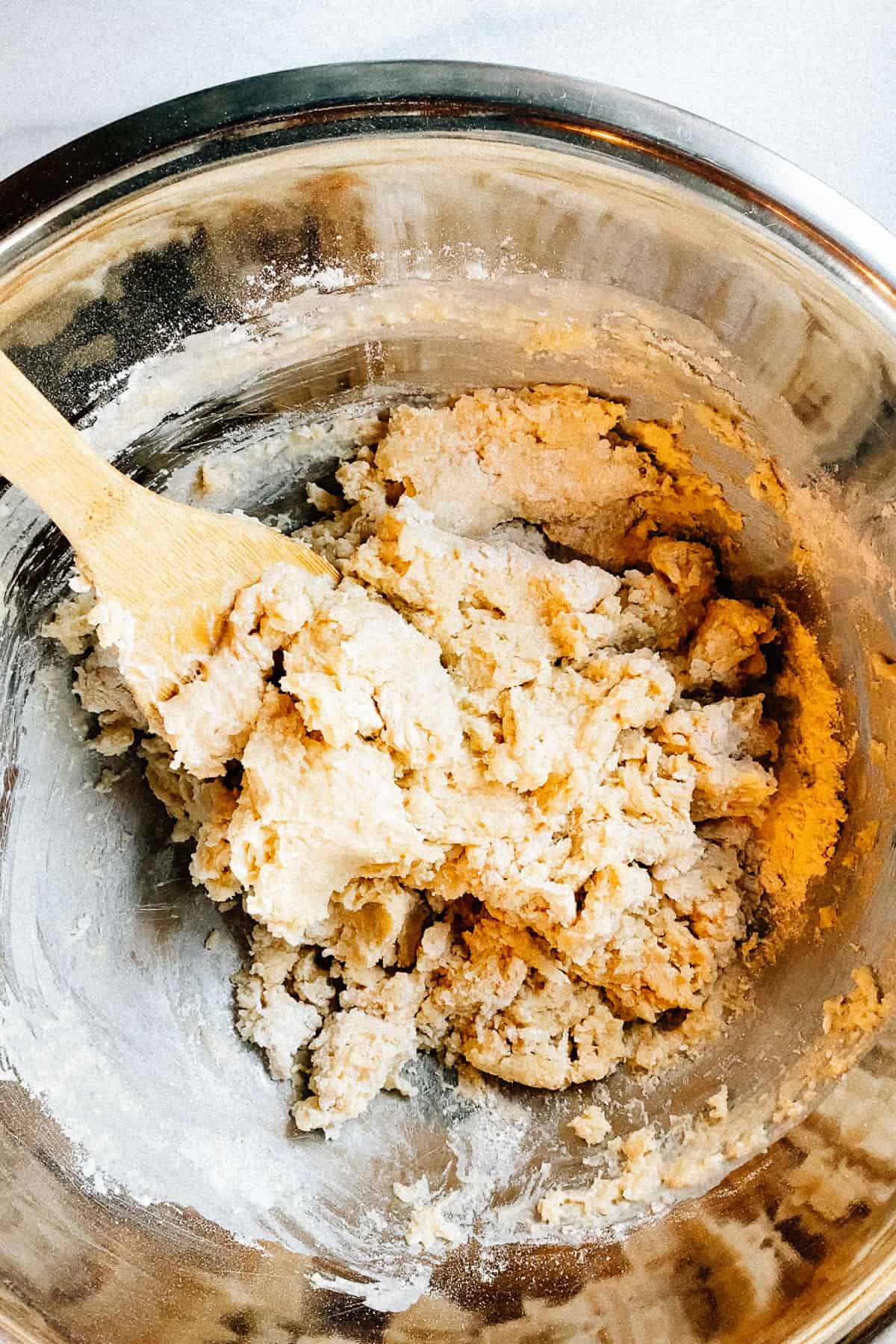
Knead for 10 minutes by hand until smooth, or 5 minutes with dough hook with a stand mixer.

Add the softened vegan butter and knead for another 2 minutes until the dough passes the windowpane test.
Tear a relatively large piece of the dough and stretch it. You should be able to see light through it without the dough tearing. Otherwise, keep kneading to form more gluten bonds.
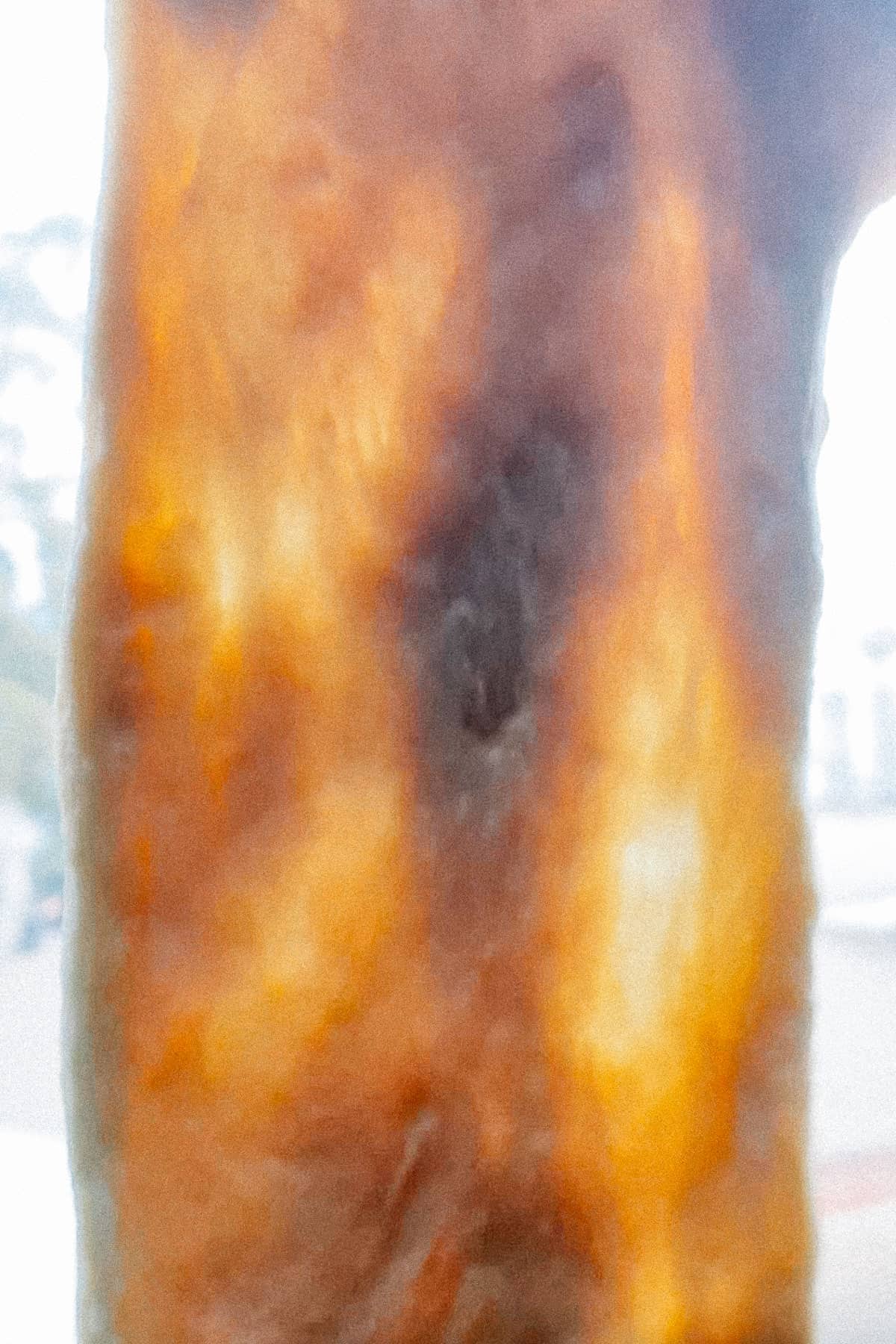
Cover with cling wrap and set aside until doubled in size.

This step is optional, but I'd highly recommend gently deflating, reshaping, then refrigerating the dough overnight after the first proof. Chilling the dough overnight develops more flavor and makes it a lot easier to work with the next day.
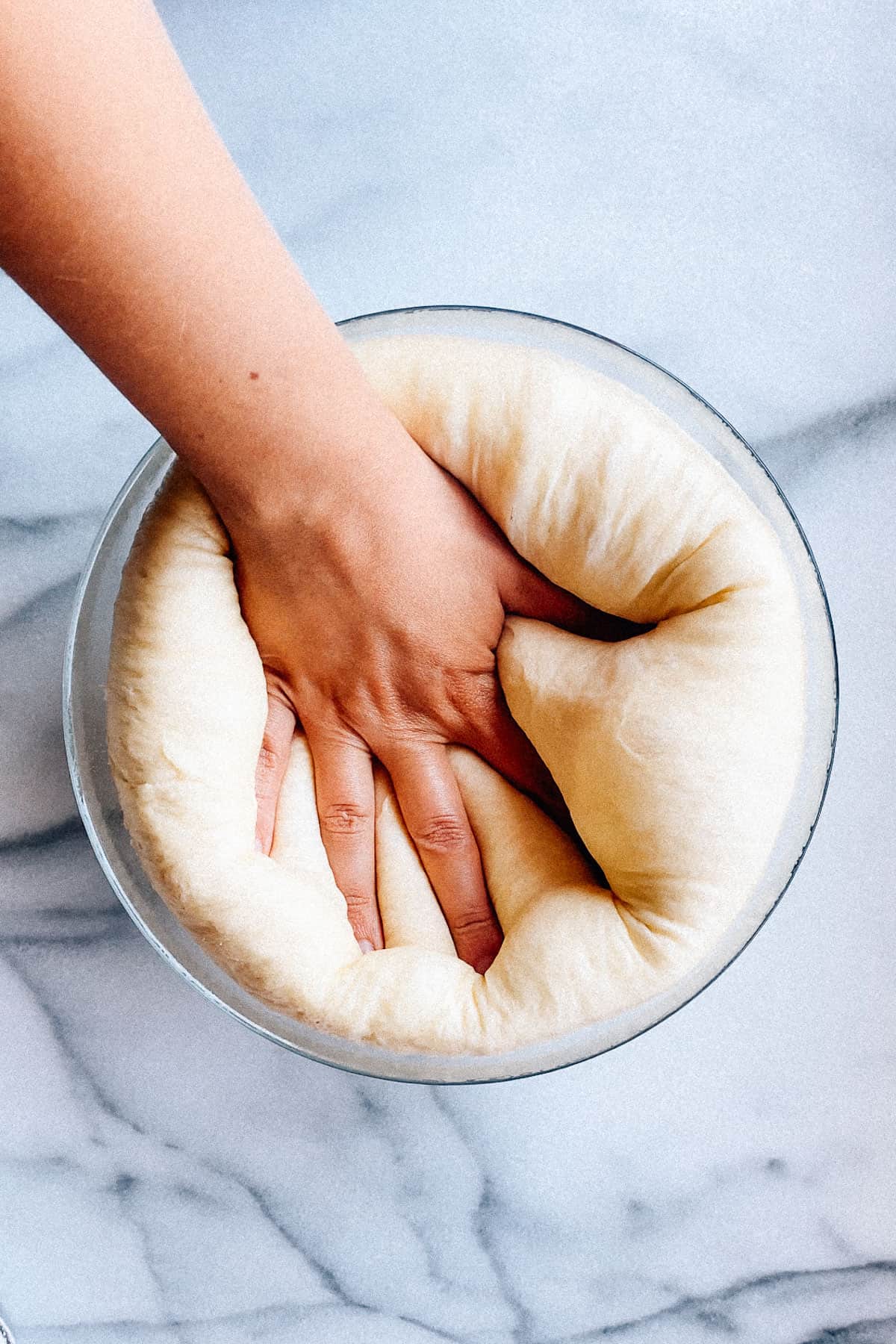
Roll and Cut
Flour a working surface and place the dough. Lightly knead, tap with rolling pin, and divide into halves. Cover the piece you’re not using with cling wrap.

Roll out the dough into ½” thickness and cut with a 3 to 3.5-inch, sharp doughnut or biscuit cutter. Cut the middle with a small (½ to 1-inch), circular object or use a donut cutter (this is the one I use). Place these donut holes aside.
I make faint indentations with the cutter first to maximize the number of donuts, then proceed with cutting.

Re-roll the leftover dough, let rest for at least 30 minutes, and repeat—only once.
If making filled donuts without a hole, you may also divide the dough into equal portions and roll them into smooth balls instead of cutting them.
Second Proof and Dry
Place each donut onto an individual small piece of parchment paper and place them on baking sheets. Put the trays in an oven (that's off) and place a bowl of boiled water next to them. The steam will prevent a skin from forming.
Alternatively, you can cover the cut donuts with cling wrap. Repeat the process for the remaining piece of dough.
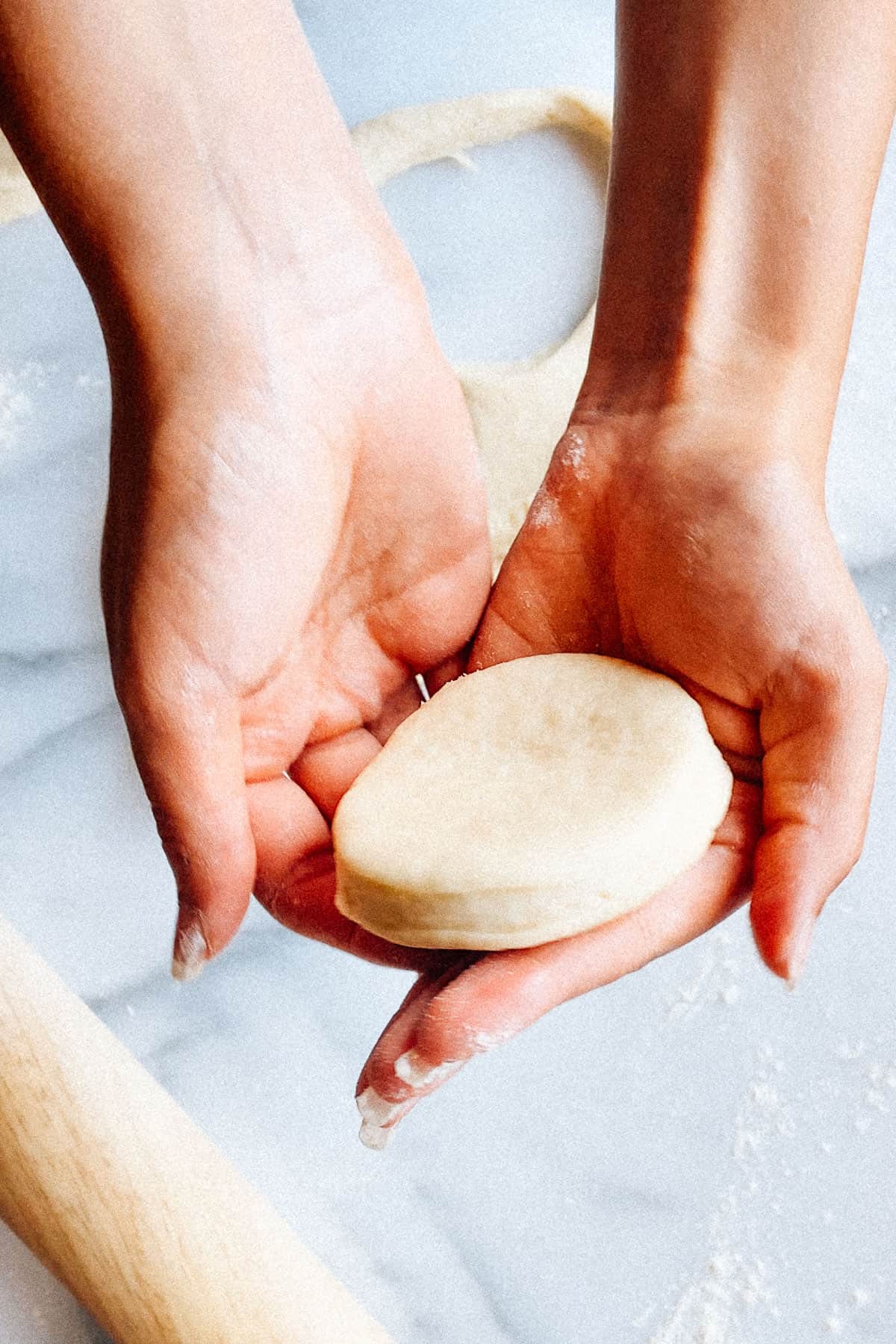
Let the cut donuts rise for 15 minutes to an hour, depending on your climate. Gently poke a cut piece of dough with your index finger and observe. If the indentation stays, your dough is properly proofed and ready to be fried. If the indentation immediately returns to the surface and disappear you'll need to proof for longer.
When the pieces are properly proofed, take them out of the oven (or remove cling wrap) to dry off the skin for a few minutes.
Fry
Start heating the frying oil as soon as the first batch of dough is cut to minimize the chances of overproofing.
Pour vegetable oil into a heavy-bottomed pan at least 2-3 inches high and heat to 375ºF.
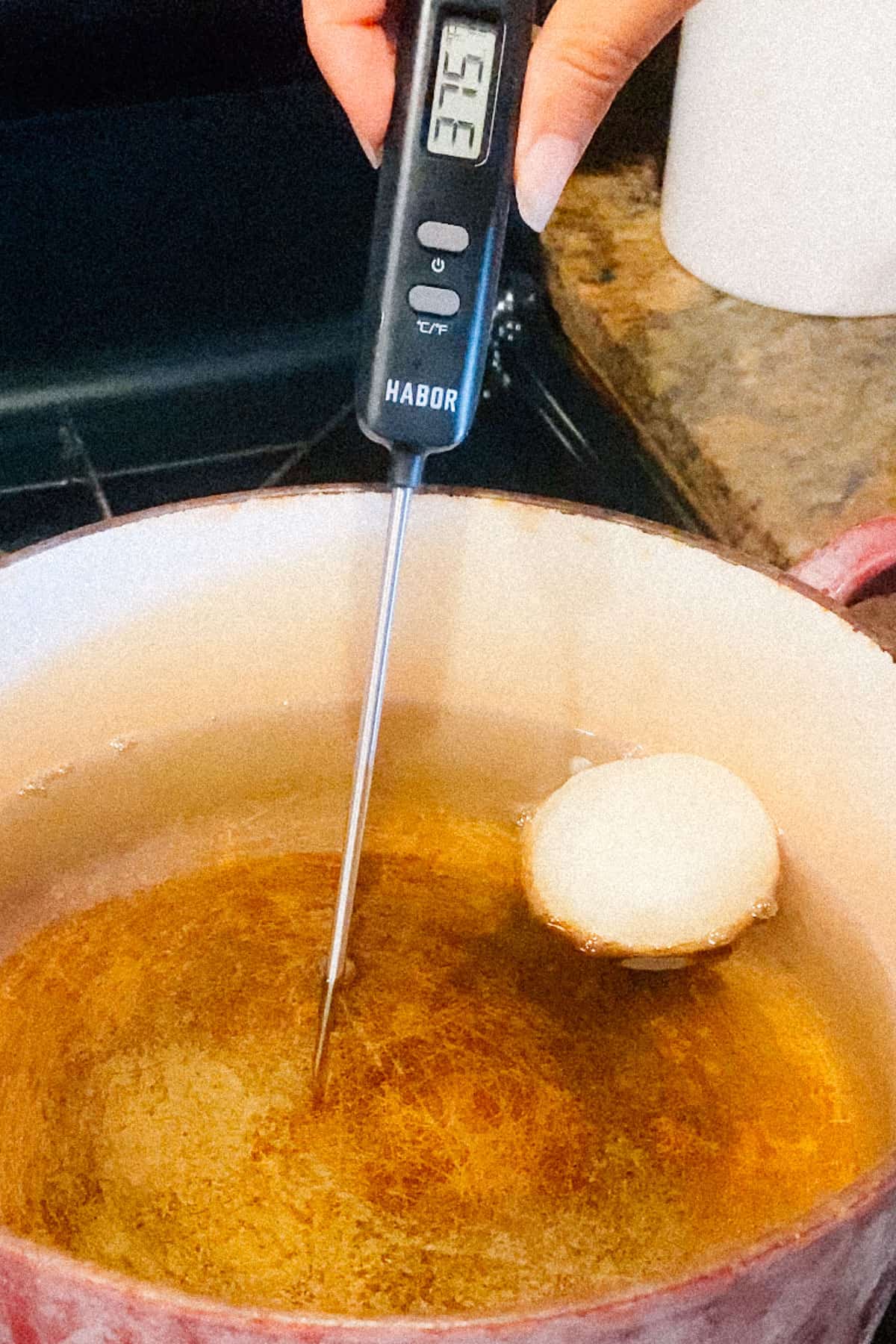
Test with a donut hole—they should turn golden brown in 30-45 seconds on each side. Make sure to start frying the batch you started proofing first.
Place 2 or 3 donuts into the pan at a time along with the parchment paper. You can remove the parchment paper after a few seconds with tongs.
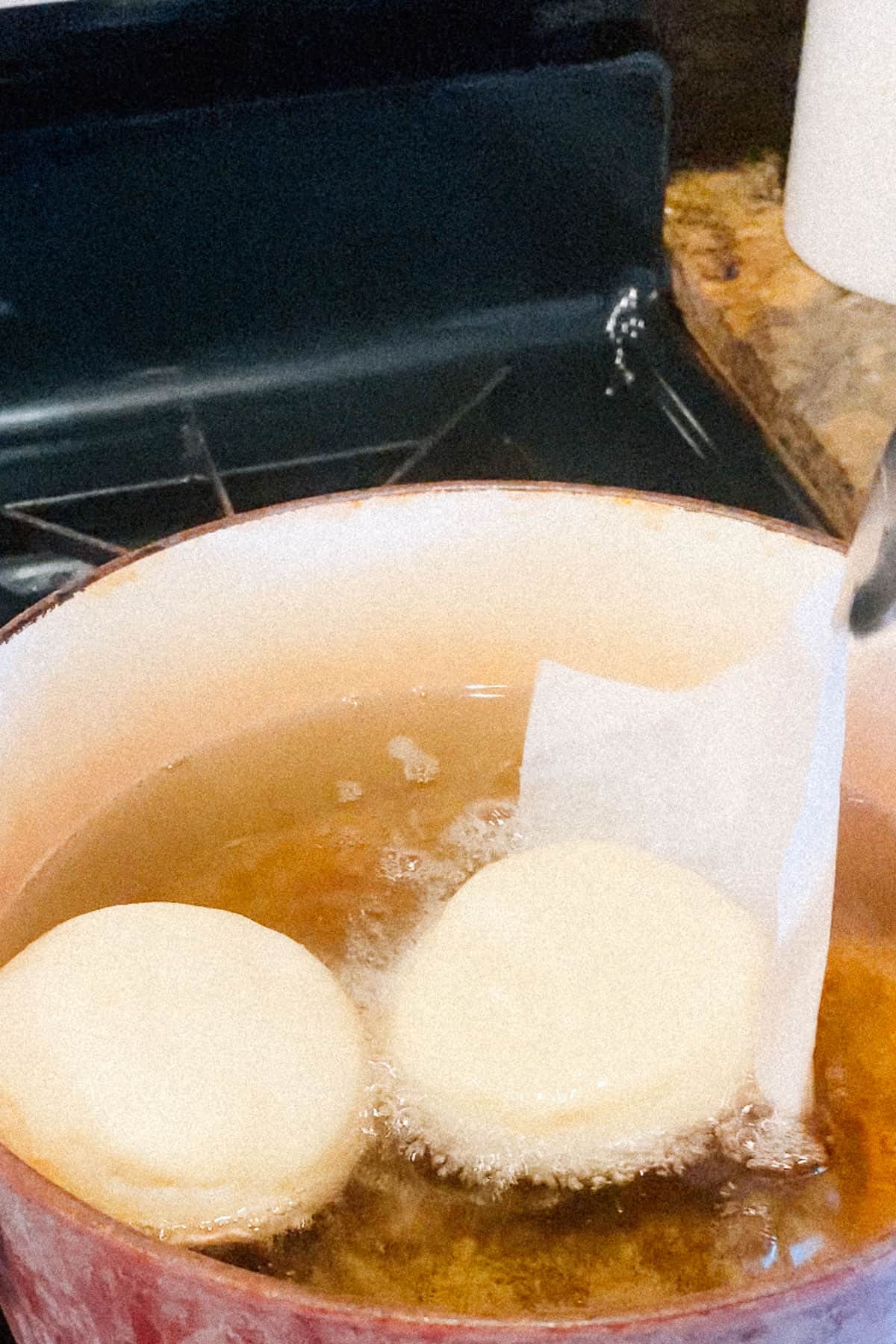
Let the underside take on a golden brown color (about 45-60 seconds) then turn and fry the second side. Be conservative with the color: when the frying oil drains off the donut, it will be darker in color.
Chopsticks or a Danish dough whisk are very helpful when turning the donuts.
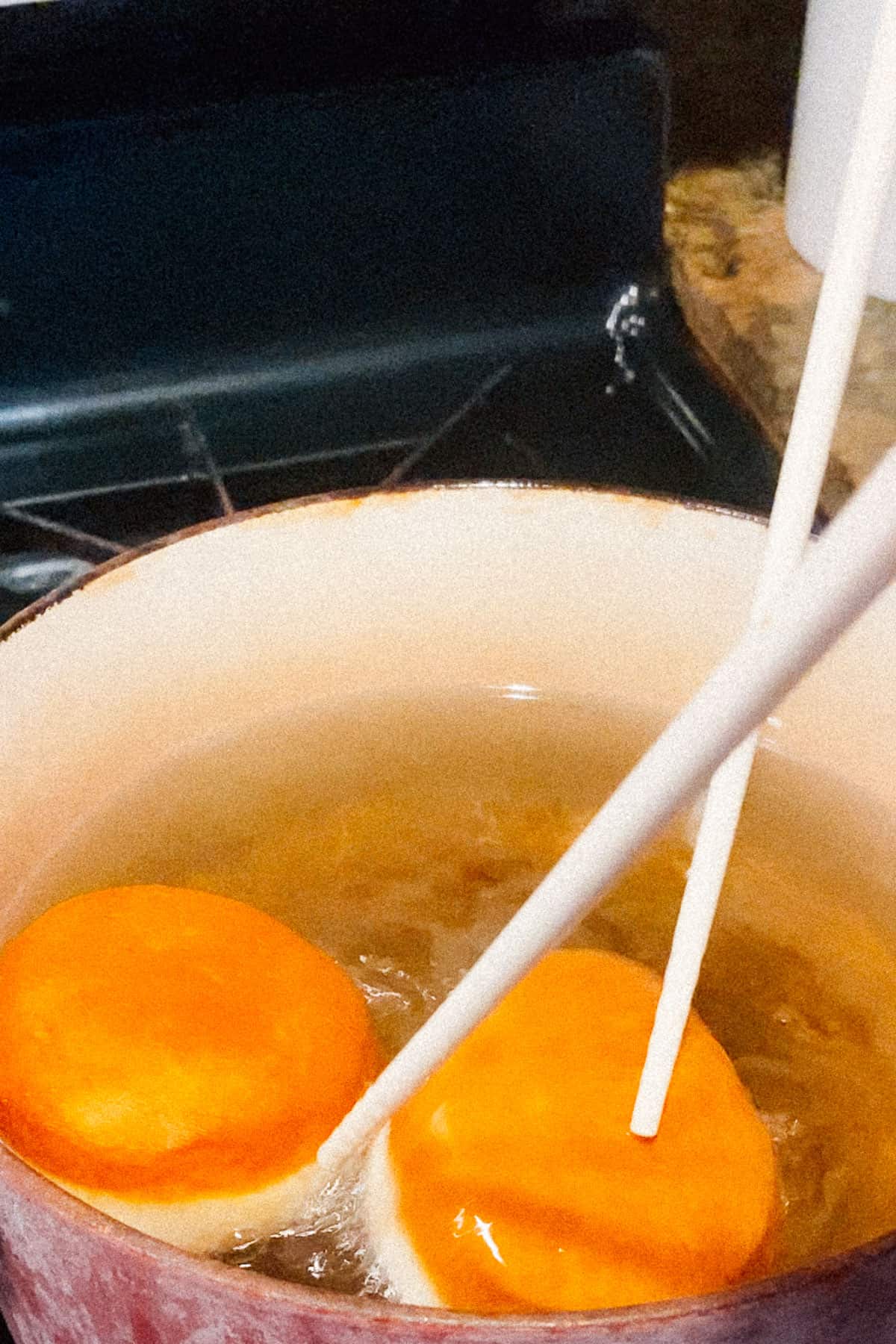
Remove fried donuts with a steel mesh spider and transfer onto paper towels.
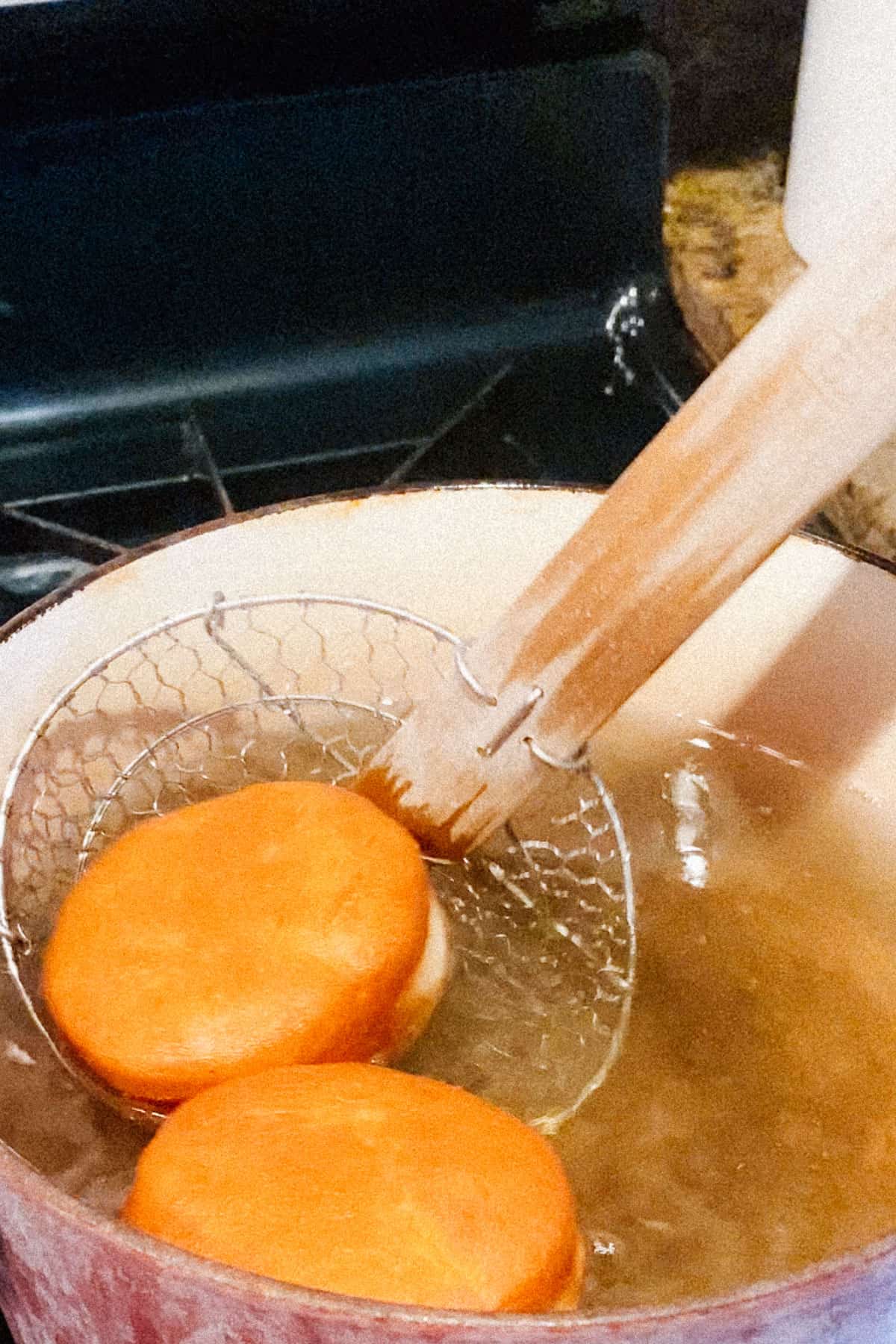
Let the donuts cool on a wire rack before glazing.
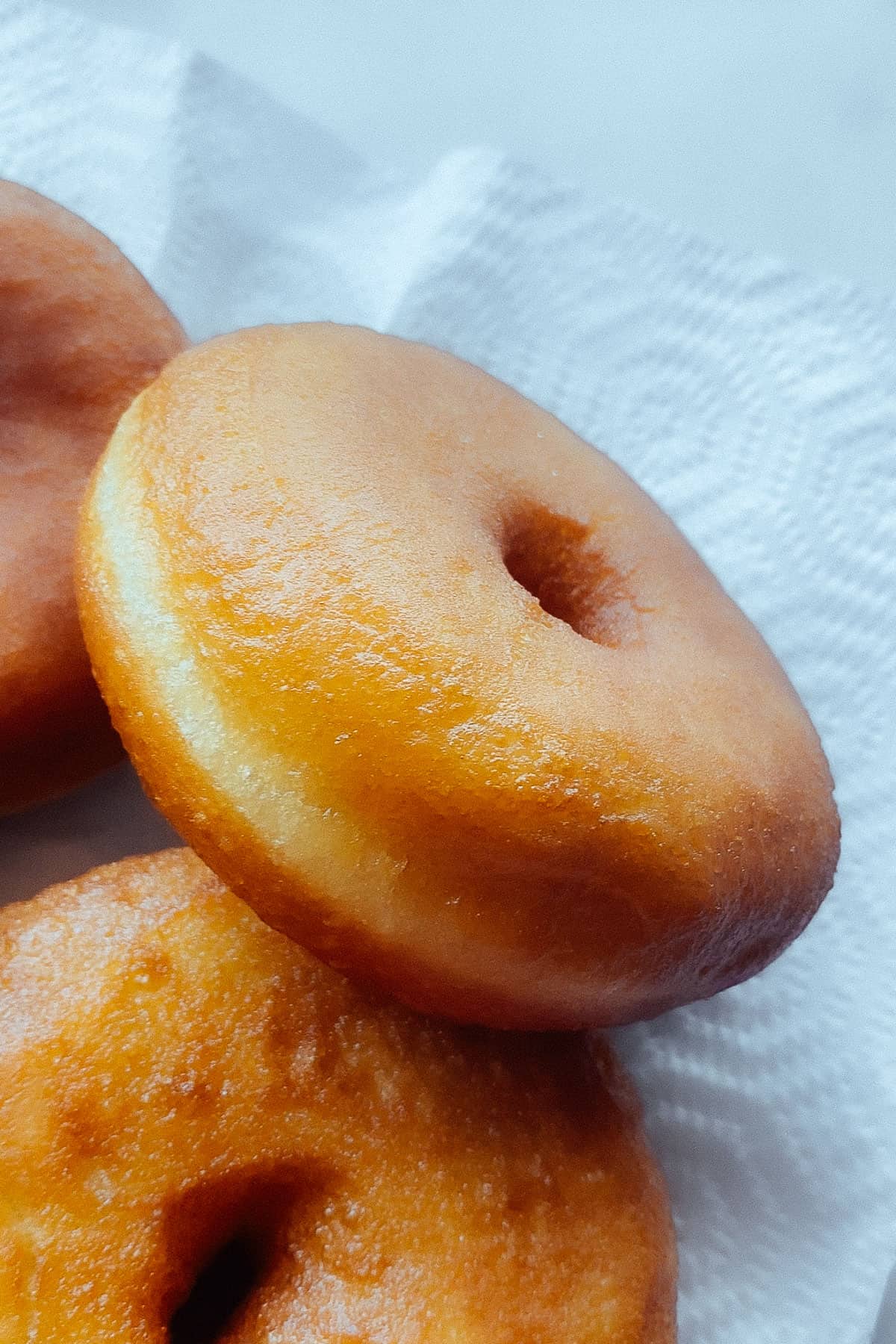
See that Saturn ring around the donut? That's exactly what you want! It shows that our donuts were proofed and fried perfectly.
Glaze
Meanwhile, make the glaze by sifting the powdered sugar and mixing it with vegan butter and plant milk, added gradually. If you'd like, add food coloring for different decorations or reduce the amount of milk for a thicker glaze.
Drizzle over donuts on a cooling rack or parchment. Enjoy!

⏰ Storing Vegan Yeast Donuts
Here is where this recipe is different than Krispy Kreme's. Since we didn't use 33 ingredients, many of which are added to extend shelflife, these donuts are best enjoyed on the very same day you make them.
To eat on the next day, make sure to glaze right after cooling and keep at room temperature in an airtight container. You may also freeze fried donuts individually and thaw & glaze them when ready to eat.
❗️ Troubleshooting Yeast Donuts
Yeast donuts take far longer and are generally more difficult to make than cake donuts. Especially if this is your first time, getting familiar with the following concepts makes preparing yeast donuts a breeze and easy to troubleshoot if necessary!
Proofing
Getting the proof right is absolutely essential. Over-proofed dough will soak up way too much oil during the frying process to a point that the donuts may even become inedible.
The photo below is from one of my earlier attempts where this was exactly the case. It was a 90-degree day and even 30 minutes ended up being way too long for the second proof.
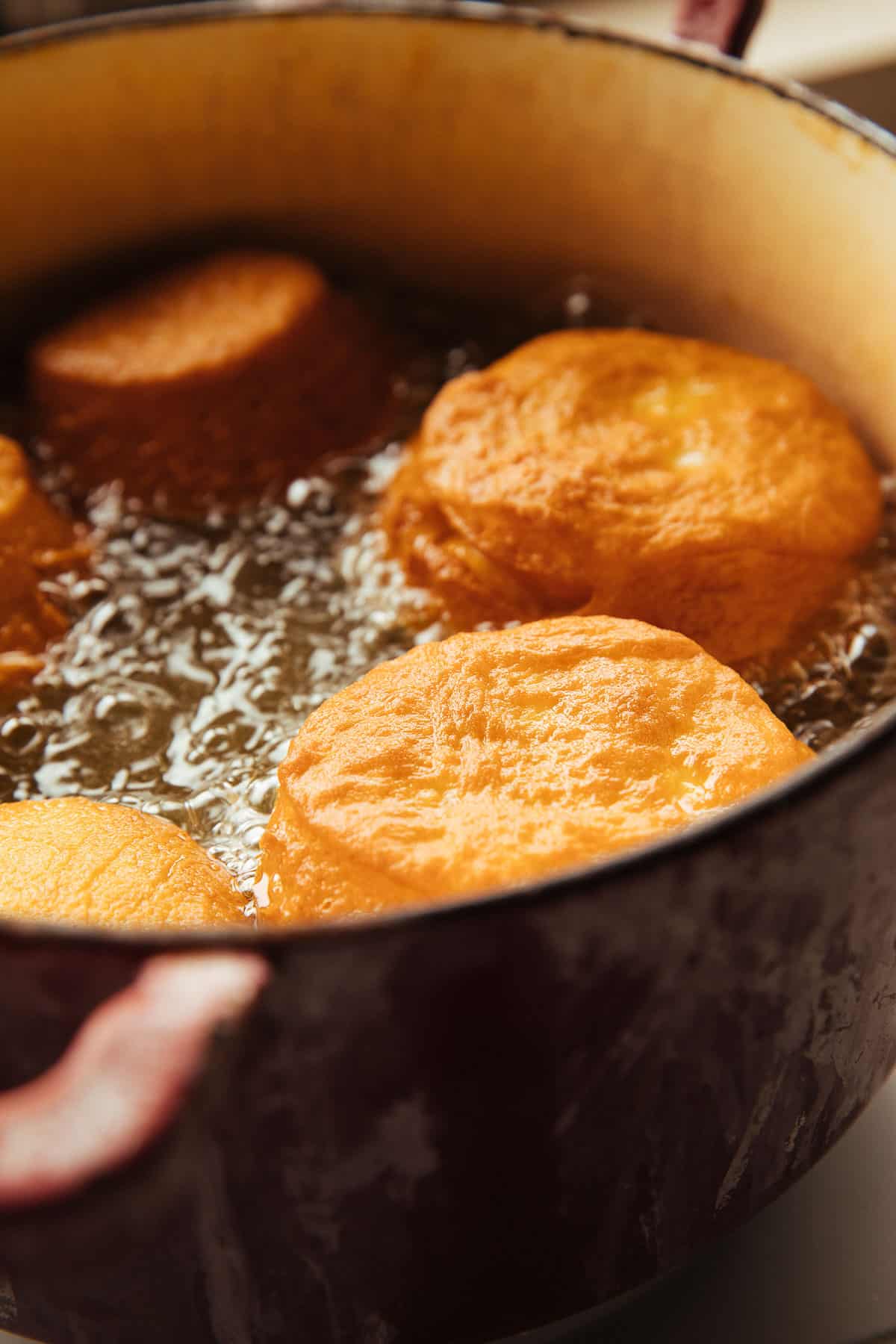
The easiest way to time this second proof is the poke test.
Gently poke a cut piece of dough and observe: does the indentation immediately return to the surface and disappear? Underproofed.
If the indentation stays, your dough is properly proofed and ready to be fried!
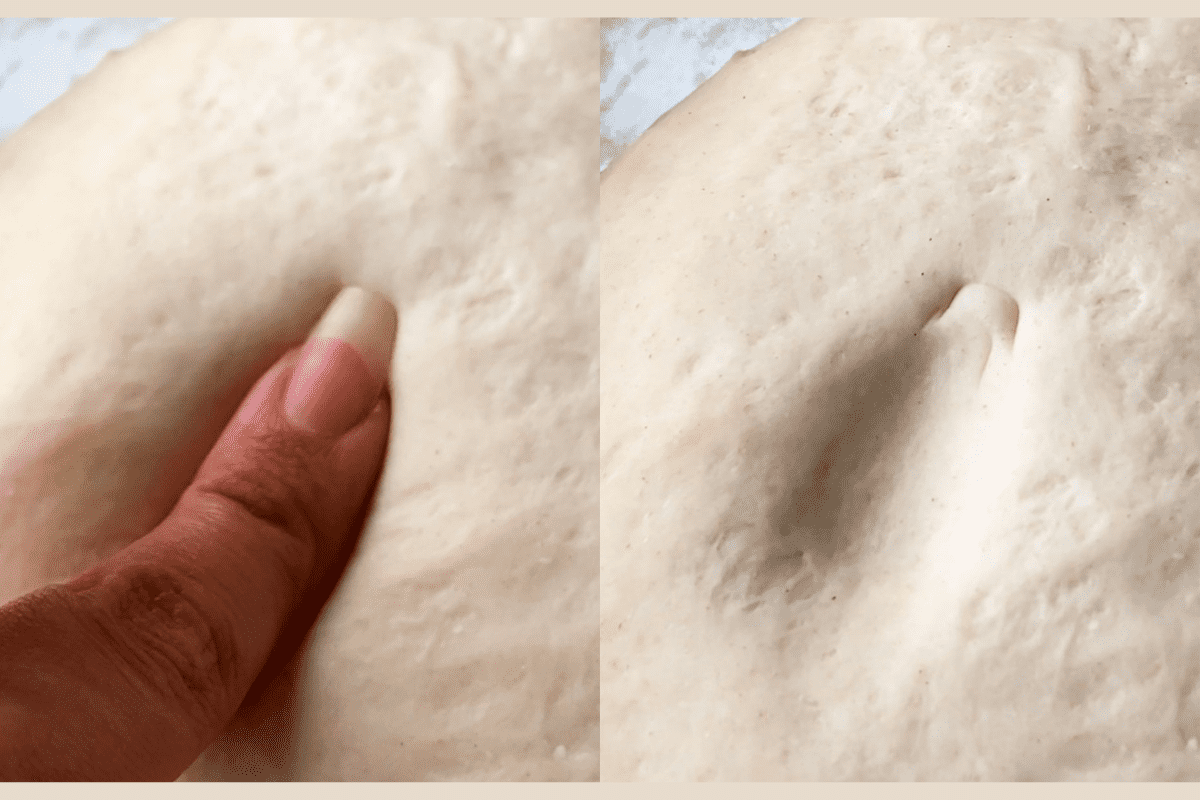
However, if gently poking deflates the entire piece of dough in addition to leaving an indentation, the dough is overproofed. This dough will need to be re-kneaded and chilled in the fridge.
Drying the Dough
When the cut dough is properly proofed, make sure to remove any cover and let them "dry" for 5-15 minutes. This step forms a crust on the donuts and makes them easier to handle.
Oil Temperature
You may have seen instructions that suggest frying at temperatures as low as 330°F to make the donuts "softer". Ignore them.
Temperatures lower than 360°F will cause the oil to get absorbed by the dough. If you want the donuts to be on the softer side, simply shorten the frying duration by 5-10 seconds on each side.

Start heating the oil as soon as all the dough is cut. If needed, just turn down the flame and wait until the poke test tells you it's time to fry. This way we're minimizing the chances of overproofing the dough.
Oil Level
Make sure to have at least 2-3 inches of neutral oil in a heavy-bottomed pan. Do not attempt to shallow-fry donuts! Remember Q = m * c * ΔT?
The lower the amount of oil at the proper temperature, the faster the temperature will drop as you fry more dough. This means oily donuts!

Frying
Let the underside take on a golden brown color (about 45 seconds) then turn and fry the second side. Keep in mind: when the frying oil drains off the donut, it will be darker in color.
Safety First
Frying in a home kitchen doesn't come without risk. Take these few easy precautions:
- Use a heavy-bottomed pan to prevent the vessel from moving around too much
- Keep a well-fitting lid nearby in case the oil catches fire and you need to cut off the oxygen supply
- Never leave the pot unattended
- Wear long sleeves
- Leave the oil to cool completely to dispose safely
🍓 Recipe Variations
Donuts are my favorite non-Turkish dessert. You can make so many different types of donuts with this simple recipe!
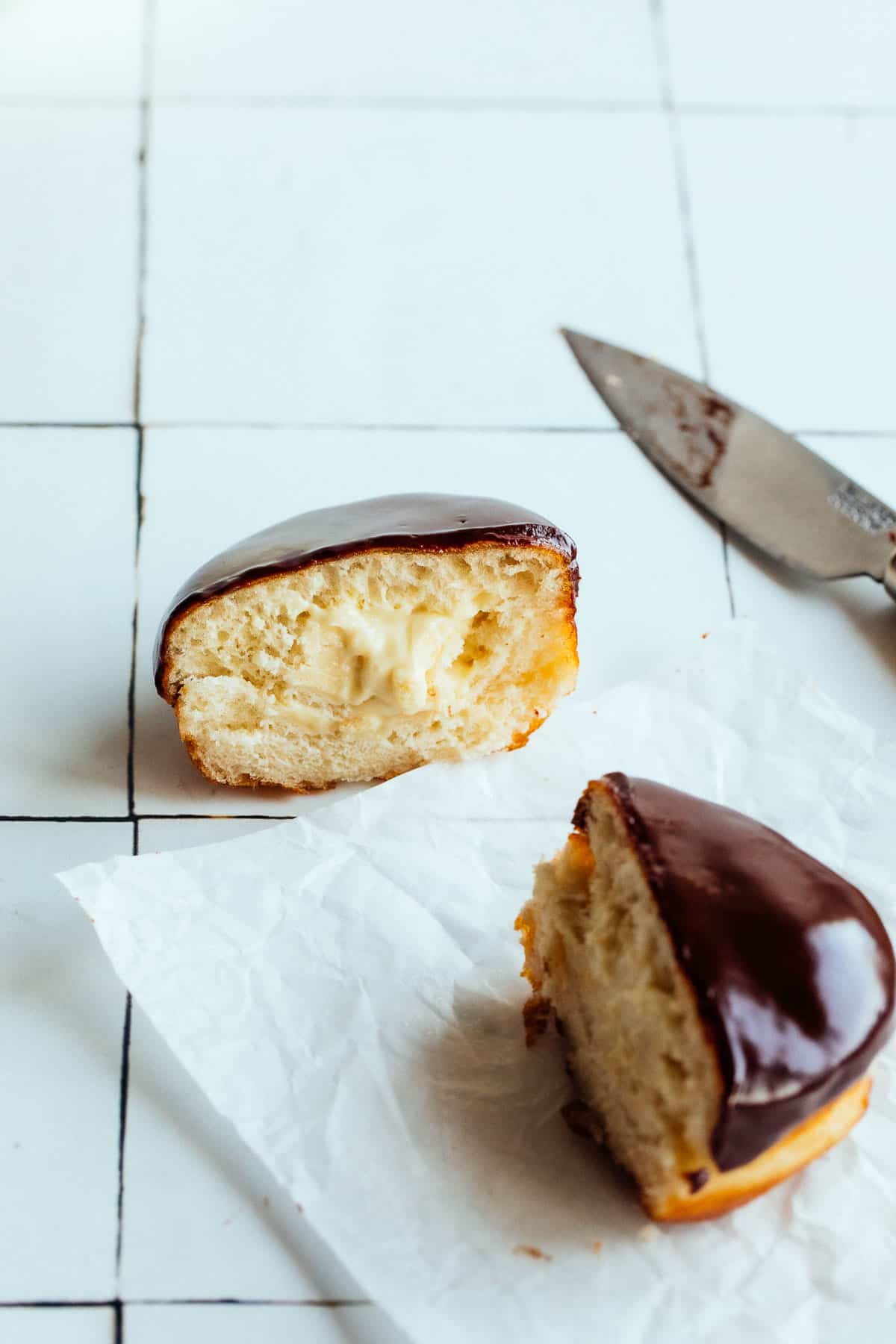
Make a Boston cream pie with vegan pastry filling and chocolate glaze, a crème brûlée variation with a hard caramel top, or fill with jam!
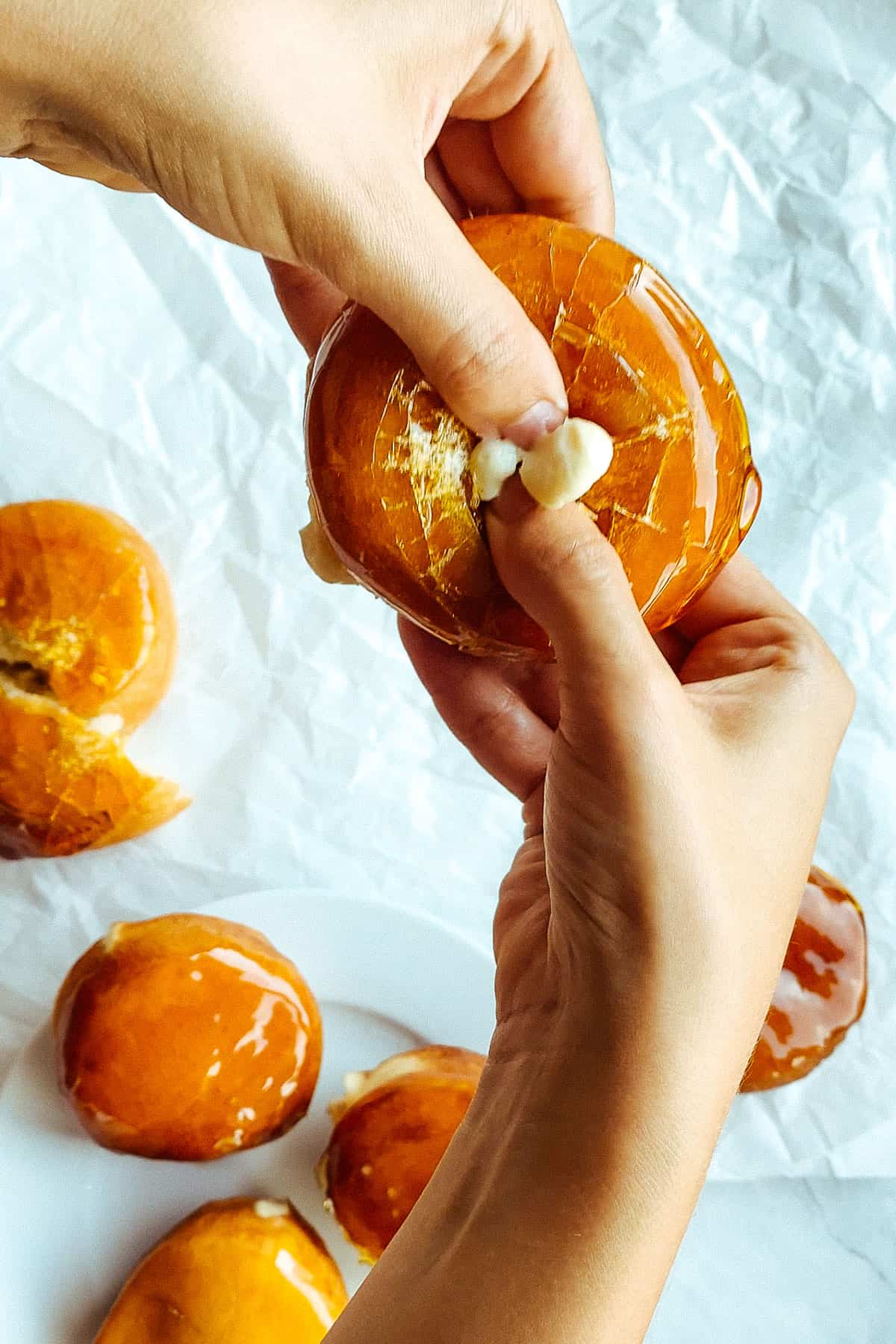
❓ Vegan Donut FAQs
Regular Krispy Kreme donuts are not vegan. They have dairy (milk powder) as well as eggs in the original dough recipe, as well as milk in their glaze.
However, Krispy Kreme UK offers many vegan-friendly options such as fudge brownie bliss. apple custard crumble, and their original glazed donut!
As of 2022, Krispy Kreme does not have any vegan options outside of the UK.
Usually, no. Glazed donuts often have dairy and eggs.
Raised vegan donuts are made of flour, yeast, sugar, salt, plant milk, vegan butter, and a suitable egg replacer.
Most donuts at bakeries are made with milk or milk powder, so they aren't dairy-free. You can easily make donuts dairy-free by replacing the dairy milk with plant-milk alternatives like soy or oat milk.
Vegan donuts don't have dairy milk, eggs, butter, or lard. These ingredients are replaced with substitutes such as plant milks, vegan butter, aquafaba, and starches.
Not really. Vegan donuts still have plenty of flour, fat, and refined sugar. It surely is healthy for the mind once in a while though 🙂
Usually, no. Both cake and yeast donuts often have dairy and eggs.

🍫 More Vegan Desserts
Try the vegan vanilla cake for another classic dessert or surprise your loved ones (including yourself!) with Turkish delight.
Did you make this vegan yeast donuts recipe? I'd love to hear about it! Please comment and leave a star🌟 rating below. This helps me run Aegean Delight and I always appreciate it 🙂
Print📖 Recipe

Perfect Vegan Yeast Donuts - Krispy Kreme Copycat
- Total Time: 5 hours
- Yield: 12 Donuts 1x
- Diet: Vegan
Description
You'll love these perfect vegan yeast donuts! Fluffy and delicious, this simple recipe is as close as it gets to a classic glazed Krispy Kreme donut.
Ingredients
- scant ½ cup (100 ml) aquafaba
- 3 tablespoons (22.5 g) cornstarch
- 2 teaspoons (5 g) instant yeast
- scant ½ cup (100 ml) water, lukewarm
- pinch of sugar (to mix with yeast)
- 4 cups (500 g) all-purpose flour
- ⅓ cup (65 g) sugar
- 1 teaspoon (6 g) table salt
- ⅔ cup (165 ml) soy milk
- ⅓ cup (80 g) vegan butter, room-temperature
- 3+ cups vegetable oil for frying
For the Glaze:
- 1 cup (125 g) powdered sugar
- 1 teaspoon (10 g) vegan butter
- 2 tablespoons (30 ml) soy milk
Instructions
Make the Egg Replacer:
- Mix the aquafaba with cornstarch and set aside.
Bloom the Yeast:
- Mix the yeast with lukewarm water and 1 teaspoon of sugar; set aside until frothy.
Knead and First Proof:
- Place all dry ingredients (flour, sugar, salt) into a large bowl and make a well in the center. Pour in the aquafaba & cornstarch mixture, soymilk, and yeast mixture.
- Mix with a wooden spoon until the dough somewhat comes together. If you want an easier time kneading, let this coarse mixture rest for 30 minutes to autolyze.
- Knead for 10 minutes by hand until smooth, or 5 minutes with dough hook with a stand mixer. Add the softened vegan butter and knead for another 2 minutes to combine.
- Tear a piece of the dough and check if it passes the windowpane test. When the dough is stretched, you should be able to see light through it without the dough tearing. Otherwise, keep kneading to form more gluten bonds. See photos in the article.
- Cover with cling wrap and set aside until doubled in size.
- This step is optional, but I'd highly recommend gently deflating, reshaping, then refrigerating the dough overnight after the first proof. Chilling the dough overnight develops more flavor and makes it a lot easier to work with the next day.
Roll and Cut:
- Lightly flour a working surface and place the dough. Gently knead, tap with a rolling pin, and divide into halves. Cover the piece you’re not using with cling wrap.
- Roll out the dough to ½” thickness and cut with a 3 to 3.5-inch, sharp doughnut or biscuit cutter. Make faint indentations with the cutter first to maximize the number of donuts. Cut the middle with a small (½ to 1-inch), circular object or use a donut cutter (this is the one I use). Place these donut holes aside.
- Re-roll the leftover dough, let rest for at least 30 minutes, and repeat—only once.
- If making filled donuts without a hole, you may also divide the dough into equal portions and roll them into smooth balls instead of cutting them.
Second Proof and Dry:
- Place each donut onto an individual small piece of parchment paper (4-in by 4-in) and place them onto baking sheets. Put the trays in an oven (that's off) and place a bowl of boiled water next to them. Close the oven door. The steam will prevent skin from forming on the donuts. Alternatively, you can cover the cut donuts with cling wrap.
- Repeat the cutting and proofing processes for the remaining piece of dough.
- Let the cut donuts rise for 15 minutes to an hour, depending on your kitchen's climate. Gently poke a cut piece of dough with your index finger and observe. If the indentation stays, your dough is properly proofed and ready to be fried. If the indentation immediately returns to the surface and disappears, you'll need to proof for longer.
- When the pieces are properly proofed, take them out of the oven (or remove cling wrap) to dry off the skin for a few minutes.
Fry:
- Start heating the frying oil as soon as the first batch of dough is cut to minimize the chances of overproofing. Pour vegetable oil into a heavy-bottomed pan at least 2-3 inches high and checking with a thermometer, heat to 375ºF.
- Test with a donut hole—they should turn golden brown in 30-45 seconds on each side. Make sure to start frying the batch you started proofing first.
- Place 2 or 3 donuts into the frying pan at a time along with the parchment paper. Remove the parchment paper after a few seconds with tongs.
- Let the underside take on a golden brown color (about 45-60 seconds) then turn and fry the second side. Be conservative with the color: when the frying oil drains off the donut, it will seem darker. Chopsticks or a Danish dough whisk are very helpful when turning the donuts.
- Remove fried donuts with a steel mesh spider and transfer them onto paper towels. Let the donuts cool on a wire rack before glazing.
Glaze:
- While the donuts are cooling, make the glaze. Sift the powdered sugar and mix it with vegan butter and plant milk, adding it 1 tablespoon at a time.
- If you'd like, add food coloring for different decorations or reduce the amount of milk for a thicker glaze.
- Drizzle over donuts on a cooling rack or parchment. Enjoy!
Notes
Please use a scale.
These donuts are best enjoyed on the very same day you make them. To eat on the next day, make sure to glaze right after cooling and keep it at room temperature in an airtight container. You may also freeze fried donuts individually and thaw & glaze them when ready to eat.
Times for kneading and proofing are estimates. Go for the windowpane and poke tests to judge the next steps.
- Prep Time: 1 hour
- Cook Time: 30 minutes
- Category: Dessert
- Method: Fry
- Cuisine: Universal
This recipe has been adapted (made vegan) from Christina's Cucina.
Pin me for later:
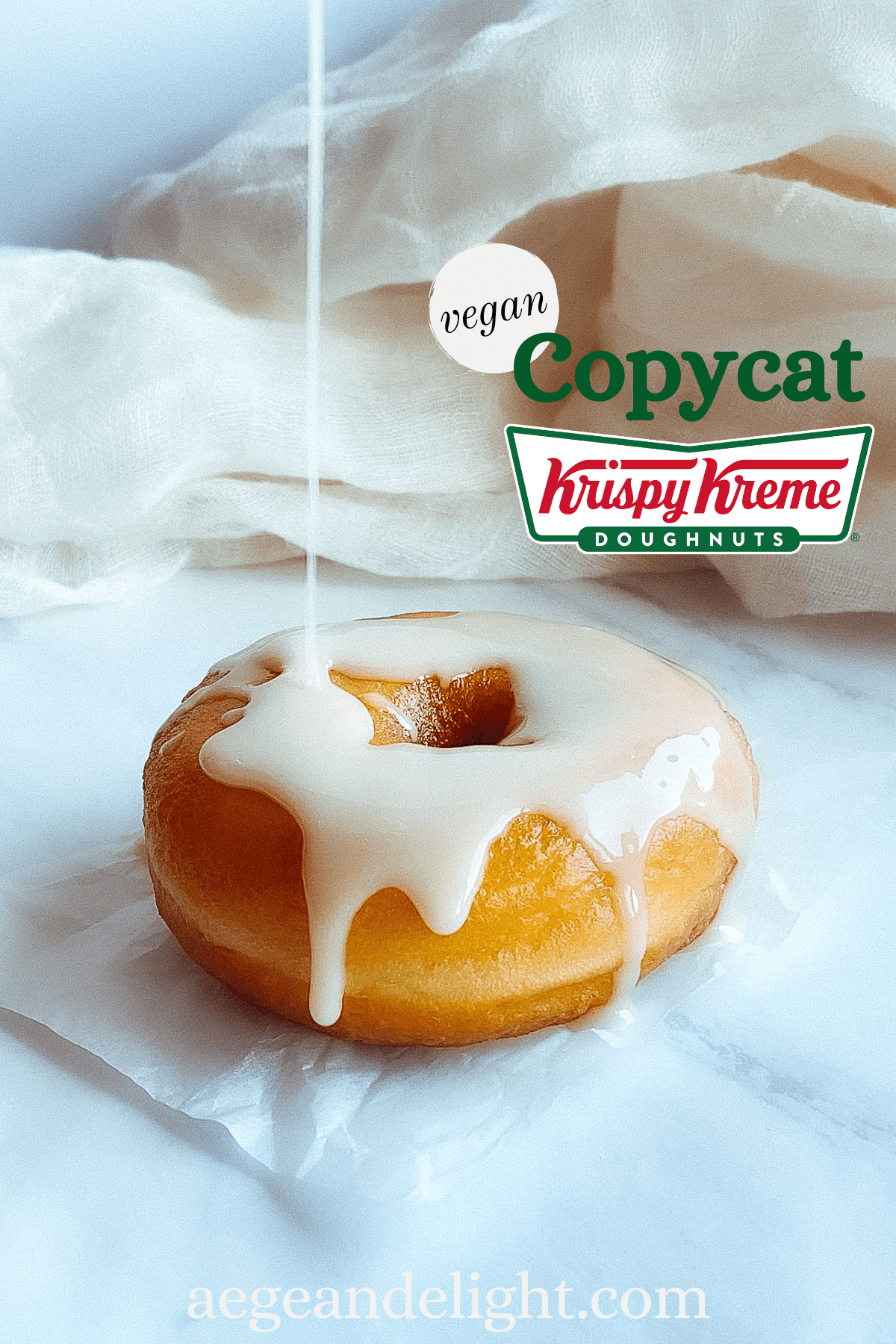




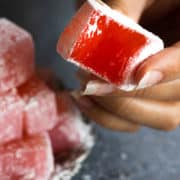
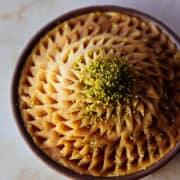
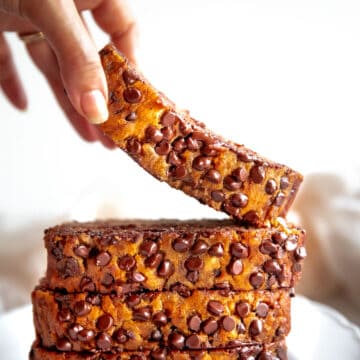

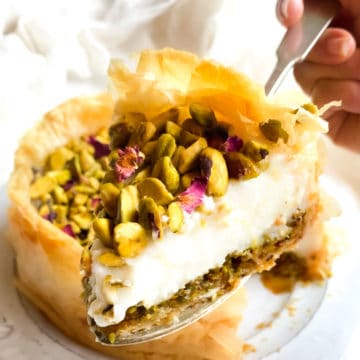
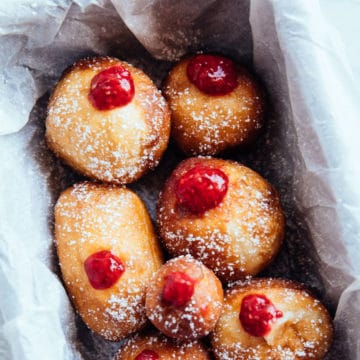


Karen
So delicious and soft.
I always had a problem with oily donuts and this recipe helped me pinpoint why. I wasn't using enough oil which dropped temperature.
Gönül
Thanks for trying out the recipe, Karen! I had a problem with oily donuts earlier on as well, caused by over proofing. Glad you solved the problem!
Stephanie
Very good. Had no problem with the recipe.
Gönül
That’s great to hear! Thanks for trying and reporting back 🙂
Lisa Delacruz
I’m a year late but wow so good best donut I’ve ever made , due to a good recipe obviously so thank you so much
Gönül
Thanks so much for trying these donuts and sharing your experience! Much appreciated 🙂
Susan
I accidentally mixed the vegan butter in with it all instead of kneading first and then adding and I used water in place of soy milk for the batter and the glaze but it still came out really good! Also, I baked some of them in the air fryer and those came out really good too. Excellent recipe, this one is definitely a keeper. Thank you for sharing
Gönül
Ooh in the air fryer you say!! I’ll have to try that for sure 🙂 Thanks so much for taking the time to leave a comment! Cheers!
DW
I just made these and they came out great! My family loved them. I didn't mix the cornstarch and aquafaba separately, and I didn't proof the yeast in a separate bowl. I just combined everything in the bowl and it worked out well. The troubleshooting section really helped! Before I found this recipe I was overproofing my doughnuts, which made them oily and gross. These came out great, thank you for the recipe and the tips!
Gönül
Awesome!! Great to hear simplifying the steps worked out well, I might try that next time myself 🙂 Cheers!